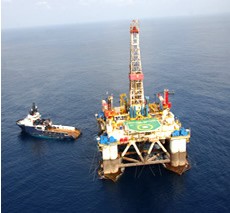Special topics
 Uganda has adopted the horizontal oil drilling method as a way to reduce impact on the environment and wildlife in the environmentally sensitive Albertine graben.
Uganda has adopted the horizontal oil drilling method as a way to reduce impact on the environment and wildlife in the environmentally sensitive Albertine graben.
Commercial deposits of oil, which currently stands at 3.5 billion barrels, have been discovered in the Albertine graben which incidentally also harbours key tourist attractions in national parks.
Environmentalists have raised fears that oil production would affect the rich eco-system especially because some wells are within Murchison falls national park that is rich in endangered animal species like elephants and lions.
However, experts say that besides increasing production, horizontal drilling reduces the environmental impact as opposed to the popularly used vertical drilling.
Horizontal drilling is one form of directional drilling which has been an integral part of the oil and gas industry since the 1920s. Here, wells are drilled at multiple angles, not just vertically, to better reach and produce oil and gas reserves.
Most horizontal wells begin at the surface as a vertical well. Drilling progresses until a few hundred feet above the target rock unit where the well is diverted to move horizontally.
TOTAL, the company exploring for oil in Murchison falls national park, has been the first to launch horizontal drilling in Jobi-6 appraisal well within Murchison falls national park.
Tullow also has developed a deviated well in the Jobi field, according to Wilson Mbire Tumushabe, a geologist and field monitor at the Petroleum Exploration and Production Department (PEPD) in the energy ministry.
Mbire explained that TOTAL’s Jobi-6 well runs 722 meters vertically. It was diverted at 88 degrees, from where it runs 1,725 meters horizontally.
He said that with horizontal drilling, different wells can be connected to one production well. From a single location, various wells can be drilled at myriad angles, tapping reserves miles away and more than a mile below the surface, which reduces the surface footprint of a drilling operation.
“Horizontal wells are better producers and are the best in terms of environmental conservation,” Mbire said. He was addressing Ugandan and Tanzanian journalists under the oil reporting fellowship organised by the African Centre for Media Excellence (ACME) and the Revenue Watch Institute (RWI)
A rig at Jobi-6 well which TOTAL has drilled horizontaly. PHOTO/Francis Kagolo
Edgar Buhanga, the natural resource coordinator at the Uganda Wildlife Authority (UWA), described horizontal drilling as the best technology in environmentally sensitive zones like national parks as well as busy areas like urban centres and residential areas.
“We have been pushing for it for so long because it reduces the number of surface infrastructure that would be put in place for oil production,” Buhanga said.
“Vertical drilling involves removal of vegetation in various areas to put up drilling pads. With horizontal drilling, you access many oil pockets within the ground from the same point.”
Horizontal drilling has been used in areas like the Marcellus Shale of the Appalachian Basin and the Bakken Formation of North Dakota where it is credited for hitting targets that cannot be reached by vertical drilling.
“When directional drilling is combined with hydraulic fracturing some rock units which were unproductive when drilled vertically can become fantastic producers of oil or natural gas,” reads an article on www.rigzone.com, a popular oil and gas website run by geologists.
According to the article, horizontal drilling increases production by as much as 20 times more than that of its vertical counterpart.
In 2010, the University of Texas at Arlington was featured in the news for drilling 22 wells on a single drill pad that will drain natural gas from 1100 acres beneath the campus. Over a 25 year life-time the wells are expected to produce a total of 110 billion cubic feet of gas. Experts say the method significantly reduced the footprint of natural gas development within the campus area.
However, it said that horizontal drilling is expensive, with a possibility of costing up to three times as much per foot as drilling a vertical well when combined with hydraulic fracturing. Even so, the extra cost is usually recovered by increased production from the well.
Source: http://www.newvision.co.ug
Get the latest news and updates on Ghana’s oil and gas value chain by following us Reporting Oil and Gas on twitter @oilgasghana and like our facebook page and get at us on Google+. Subscribe to our group to get update